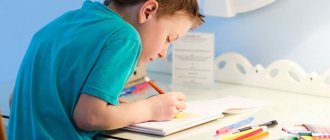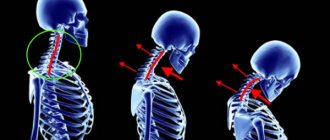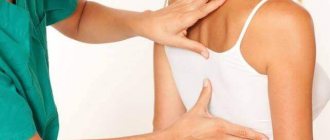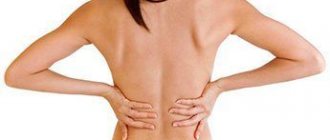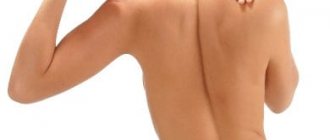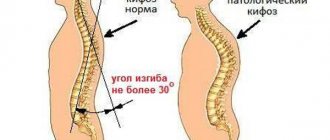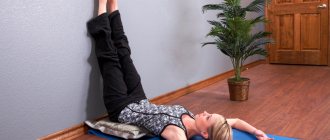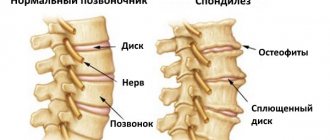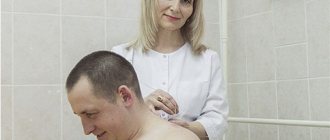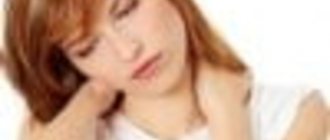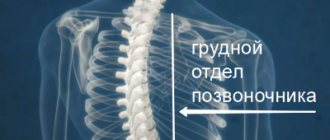Scoliosis is a persistent lateral curvature of the spine.
Scoliosis
When considering the position of the human body in space, the basic position is considered to be a standing position with arms down. The human body has bilateral symmetry. You can draw a conditional plane separating the front part of the body from the back (this plane is called the frontal plane). Considering a person in this plane, we will see that the right and left sides of a person are symmetrical. The spine will be the axis of symmetry. If it is bent to the right or left, the symmetry will be broken. Therefore, scoliosis is also called curvature of the spine in the frontal plane.
Scoliosis should be distinguished from poor posture. Poor posture is a functional condition, the lack of habit of keeping your back straight. In this case, a person, if he wants, can straighten up. Curvature of the spine is changes that a person can no longer eliminate by simply changing his posture. Such changes are recorded during instrumental studies, for example, radiography or MSCT of the spine.
Types and degrees of scoliosis
Right-sided and left-sided scoliosis
If you look at a person from the back, then the spine should normally be located strictly in a vertical straight line. When the spine is curvatured, an arch occurs. If the arch is directed to the right, they speak of right-sided scoliosis
, if to the left, then about
left-handed
.
Scoliosis is also determined by the part of the spine in which the curvature occurs. Highlight:
- cervicothoracic
or
upper thoracic scoliosis
(curvature at the level of IV-V thoracic vertebrae). This scoliosis is characterized by the occurrence of asymmetry of the shoulders; - thoracic scoliosis
(curvature at the level of VII-IX thoracic vertebrae). Deformation of the chest occurs, causing respiratory dysfunction; - thoracolumbar scoliosis
(curvature at the level of the X-XII thoracic vertebrae). Leads to serious impairment of respiratory function and cardiovascular system activity; - lumbar scoliosis
(involving the lower thoracic vertebrae and the first vertebrae of the lumbar spine).
Left without proper treatment, the disease usually progresses, which is reflected in an increase in the angle of curvature. There are the following degrees of scoliosis:
- scoliosis of the 1st degree – curvature angle up to 10 degrees;
- scoliosis of the second degree – the angle of curvature is from 10 to 25 degrees;
- III degree scoliosis – 25-40°;
- IV degree scoliosis – curvature angle greater than 40 degrees.
There can be only one lateral curve, and then the curvature resembles the letter C. This type of disease is called C-shaped scoliosis
.
A misalignment to one side significantly increases the load on the vertebrae, and in order to reduce it, a curvature of another part of the spine develops in the opposite direction. In this case, the curvature resembles the letter S. This type of disease is called combined scoliosis
or
S-shaped scoliosis
.
In some cases, there may even be three arcs of curvature ( E-shaped
or
sigma-shaped
scoliosis).
Facts about Traction Therapy
High efficiency and safety.
The method of treating spinal diseases with extensions (tractions) has been known since the time of Hippocrates. Stretching has proven itself as a method of treatment after injuries, congenital and age-related changes in the back. Traction therapy is highly effective, comfortable and absolutely safe for patients.
A unique technique.
Traction therapy of the spine using computerized 3D stretching has appeared in Russia only recently. There are very few devices of this type in Russia, literally a few. And one of them is available at the Center for Restorative Medicine and Rehabilitation of the Federal Scientific and Clinical Center of the Federal Medical and Biological Agency.
Innovative technologies.
Unlike a traditional "one-dimensional" table, where the doctor uses a mechanical device to pull the patient's body up (cervical traction) or down (through weights suspended from the legs), the Spinetronics Robotic-ATT Antalgic-Trak operates in all directions.
Professional control.
Soft, individually selected tractions directed in different directions literally straighten the spine and intervertebral discs in all directions. The intensity and duration of therapy is controlled by a computer, under the supervision of a physician.
Sign up for a consultation with a chiropractor and learn about the possibilities of robotic traction therapy specifically for your situation!
Causes of scoliosis
Scoliosis can be congenital or acquired. Congenital scoliosis is usually caused by abnormalities in the development of the vertebrae and ribs.
Acquired scoliosis in most cases develops in childhood or adolescence, when the body is actively growing. Basically, these are ages from 6 to 17 years. Bone growth ends before the age of 20, after which the development of scoliosis is less likely. In 80% of cases, scoliosis is detected in girls.
Scoliosis can be of myopathic origin, that is, it occurs due to insufficiency of the muscular and ligamentous apparatus. The development of such scoliosis is facilitated by long-term uneven loads on the spine: the habit of a lopsided posture at a desk or desk, carrying a bag in the same hand (on one shoulder), playing sports associated with the work of only one hand (tennis, badminton, shot throwing). and so on.).
The following diseases can lead to the development of scoliosis:
- rickets (impaired mineralization of bone tissue). Rachitic scoliosis; discovered, as a rule, at the age of 2-3 years;
- congenital torticollis (the disease is characterized by a constant tilt of the head to the right or left);
- cerebral palsy (CP);
- polio;
- osteochondrosis;
- intervertebral disc herniation;
- and also some others.
However, in most cases the cause cannot be identified. This type of scoliosis is called idiopathic. The hereditary factor appears to be of great importance, since scoliosis is quite often detected in members of the same family.
The effect of massage on the body
For scoliosis, massage can be performed with the hands of a neurologist
or using special devices. The essence of the effect is that certain areas of the patient’s body are specifically irritated, which will subsequently bring a positive effect. Massage has a great effect on the human body:
- rejuvenates tissues and promotes their regeneration;
- blood flow in the capillaries increases, the level of blood supply to the areas that the specialist massages increases;
- improves mood, relieves insomnia;
- relieves tension;
- makes muscles more elastic.
In addition, massages for osteochondrosis and thoracic scoliosis improve the functioning of joints, strengthen the muscular corset of the back, and a person experiences the relaxing effect of such manipulations.
Symptoms of scoliosis
Scoliosis in children - Treatment in clinics of JSC Family Doctor
Scoliosis in most cases develops in childhood and adolescence, and at the initial stage does not cause serious concern - children do not complain. Therefore, parents need to be especially careful and pay attention to external signs of the onset of the disease, such as:
- slouch;
- one shoulder is located slightly higher than the other.
The development of scoliosis leads to an increase in the angle of curvature. The vertebrae also begin to rotate around their axis (vertebral torsion). In this case, symptoms such as:
Backache
At the initial stage of scoliosis, back pain appears after a long period of standing or long walking. Subsequently, back pain becomes constant; after having to stand or walk, the pain intensifies;.
Body asymmetry
During a medical examination of a patient with scoliosis, it is discovered that one shoulder blade is higher than the other. In this case, the shoulder blades are located at different distances from the spinal column. In the later stages of scoliosis, the curvature of the spine becomes obvious: one shoulder is noticeably higher than the other. When you slowly bend forward on your back, an asymmetrical roll appears in the thoracic or lumbar spine - this is how torsion (twisting of the vertebrae) manifests itself.
A set of exercises against stooping
A set of physical exercises for the back helps strengthen the spinal muscles and also improves blood circulation in the soft tissues. This is an excellent way to correct incorrect shoulder position. However, remember that not a single complex can give a significant effect the first time. These exercises must be performed every day for fourteen days. Only in this case will you be able to improve the situation and get rid of stoop.
"Kitty"
One of the simplest and most effective exercises, which does not require any auxiliary equipment or large space. With this exercise you can stretch your back muscles and strengthen your muscle corset.
You need to get on all fours so that your knees are directly under your hips and your hands under your shoulders. Next, you should lower your head, trying to reach your chest with your chin, while your back should be in the most rounded position. Then stretch the top of your head towards your back so that the spine bends as much as possible in this position. Ideally, this exercise should be repeated up to fifty times, and preferably in the morning after sleep, as well as right before bed, to relieve muscle tension.
"Arc"
A great exercise for office workers as it strengthens the upper back. You need to stand with your back to the wall at a distance of no more than one step and lean your back on it. The arms must be bent at the elbows and placed on the neck area so that they, like the back, rest against the wall. Next, as you inhale, you need to bend forward as much as possible so that your hands still rest against the wall, and then, as you exhale, return to the starting position. It is recommended to perform this exercise slowly eight times.
"Back bend"
Get on your knees, lower your hip joint to your feet, point your toes out, place your hands behind your head. Begin to slowly rise from your heels, spreading your arms, bend back so as to maximally feel the tension in your upper back (in this position, your pelvis should move forward). Next, return to the starting position and slowly repeat this exercise up to fifteen times.
"WY"
As in the “Arc” exercise, you need to stand with your back to the wall so that your feet are at a distance of 10 cm from the baseboard. The knees should be relaxed and in a slight bend. The buttocks, head and spine rest against the wall. Next, you need to raise your arms above your head and bend them at the elbows to visually form the letter “W”. You need to stay in this position for three seconds, then straighten your elbows and raise your arms up again, visually forming the letter “Y”. The shoulders should not touch the ears. This exercise must be repeated ten times in three approaches.
"Door stretcher"
Stand in a doorway and raise one arm parallel to the floor. Bend your elbow so that your fingers point toward the ceiling. Next, place your hand on the door frame and slowly lean toward your raised hand, pressing down on the door frame for ten seconds. The same must be done with the other hand, 2-3 approaches. This will help relieve back tension and stimulate muscle tone.
Methods for diagnosing scoliosis
In the diagnosis of scoliosis, instrumental research methods are of great importance. Typically, radiography is performed. In some cases, an MRI may be required.
X-ray of the spine
An X-ray of the spine allows you to see the location of the vertebrae, determine the angle of curvature, and in some cases identify the cause of scoliosis (vertebral fusion, wedge-shaped vertebra, etc.).
More information about the diagnostic method
MRI of the spine
The diagnosis of scoliosis can be made without resorting to an MRI. However, in complex cases, an MRI examination of the relevant parts of the spine will provide the doctor with the necessary additional information. MRI can detect spinal cord injuries and also detect spinal tumors, which sometimes cause scoliosis.
Sign up for diagnostics To accurately diagnose the disease, make an appointment with specialists from the Family Doctor network.
Kyphosis. Lordosis
Kyphosis is a curvature of the spine that faces backwards. Lordosis is a bending of the spine with a convexity forward. In the normal state of affairs, these curves are physiological and help the spine to absorb shock when walking, bending, jumping, etc. However, often, under the influence of negative factors, the natural curvature of the spine acquires pathological features.
Kyphosis
Kyphosis of the spine is most often arched, but it can also be angular - in this case, the vertebrae do not protrude as an arch, but as an angle, with the spinous process at the apex. Externally, the pathology is manifested by the formation of a hump on the back.
Thoracic kyphosis is the most common type of pathology. At the initial stage (this form of spinal curvature is called stoop), the condition does not cause discomfort, and it can be shown by an x-ray or detected by a doctor during a visual examination.
As this type of kyphosis progresses, the patient develops a hump, the ribs and sternum are displaced, causing serious disruptions in the functioning of the internal organs.
Cervical kyphosis, lumbar kyphosis, and sacral kyphosis are very rare. They can occur due to trauma, infectious diseases or degenerative changes.
1 Diagnosis of kyphosis: x-ray
2 Diagnosis of lordosis
3 Treatment of scoliosis
The causes of kyphosis are often:
- abnormalities of intrauterine development;
- birth injuries;
- spinal injuries and surgeries;
- weakness of the back muscles;
- osteoporosis.
It is necessary to treat kyphosis, since this deformation provokes rapid destruction of the spine. And this entails severe pain, motor dysfunction, circulatory disorders, including cerebral, etc.
The treatment regimen for kyphosis includes drug therapy, physical therapy, massage, manual therapy, physiotherapy, and wearing a corset. It is possible to use surgical techniques.
Lordosis
Normally, the spine has a slight forward bend in the lumbar region - physiological lordosis. Pathological lordosis forms in the same area, only it is much more pronounced.
Lumbar lordosis is characterized by “duck posture”: the shoulders are lowered, the head is slightly tilted forward, the stomach is protruded, the lower back is arched, the pelvis is shifted back, and the knees are spread apart. The gait is heavy, which is explained by pain and discomfort in the lumbar region.
Spinal lordosis has a negative impact on the functioning of the heart and lungs, causing breathing and circulatory disorders.
Causes of lordosis:
- abnormalities of the spine;
- diseases of the spine, incl. intervertebral hernia;
- spinal injuries, incl. generic;
- diseases of the hip joints;
- displacement of the vertebrae (spondylolisthesis);
- systematic violations of posture in a sitting/standing position;
- low physical activity;
- systemic diseases of the musculoskeletal system;
- excess body weight;
- rapid growth of the child, etc.
Treatment of lordosis also involves the use of drug therapy, exercise therapy, massage, and manual techniques. Breathing exercises for lordosis have a good effect.
Diagnosis and treatment of spinal curvature should be carried out by an experienced doctor - a neurologist, vertebrologist, or orthopedist. Self-medication or inept treatment can cause irreparable harm to your health or the health of your loved one!
At the MedikCity clinic, highly qualified specialists, real professionals, treat pathologies of the musculoskeletal system. With us, your health is in safe and capable hands!
Rules for conducting classes
- Classes with the child should take place under the close attention of the parent and take into account his age characteristics.
- All exercises must be performed smoothly. Sudden, jerky movements and jumps are prohibited.
- If acute painful sensations appear, you must stop performing the exercise.
- For training, you need to choose light and comfortable clothing that does not restrict movement.
- The set of exercises must necessarily contain general physical training (general physical training) exercises.
- Classes must be regular: at least three times a week.
